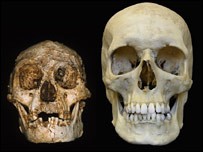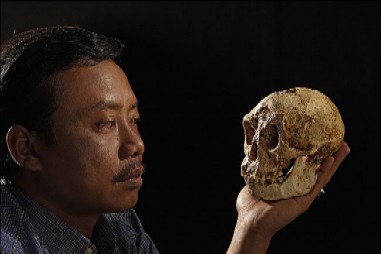
May 21, 2006

Reacting strongly to the latest round of attacks on Homo floresiensis being conducted more in the media than in reasoned reality, Peter Brown, one of the primary researchers of the new species has told Cryptomundo: "Some people see exactly what they want to see, for a variety of reasons."
Distracters, the media, and the debunkers in this current onslaught against the discovery are completely ignoring the evidence of the possibly nine Homo floresiensis individuals discovered at the site. "There are no modern humans with the postcranial dimensions of Homo floresiensis and the second mandible is well outside the range of human variation," Brown told Cryptomundo.
In a widely reported news event that is greatly extending some initial findings mentioned in the May 19th issue of Science, biologist Robert D. Martin of the Field Museum in Chicago and associates have claimed the LB1 skull is not that of a new-discovered extinct species. Instead, they say it is but a modern Homo sapiens afflicted with microcephaly, a genetic disorder characterized by a smaller than normal brain and head size.
"It’s perfectly plausible that these were pygmy people. But there’s only one skull, and that is human and microcephalic," Professor Robert Martin, the team leader of the study told the media. They dispute the dwarfing of a Homo erectus is responsible for LB1. (It should be mentioned that Martin said the Science report was a brief summary of a more detailed manuscript that will soon be submitted for publication in The Anatomical Record, a journal of anatomy and evolutionary biology. Submission is not acceptance, please note.)
When I discussed in an email that the other finds of Homo floresiensis were being ignored, Alan Mann, professor of anthropology at Princeton University, reinforced Martin’s point of view in an online reply: "I am aware of the other, very fragmentary materials, but they show nothing of the features that would distinguish these guys from the very small living locals."
Peter Brown, however, denounces this in an exclusive to Cryptomundo, and says critics should be asked "to point you at a human mandible with the same features as those from Liang Bua. Claiming that they have the same features as small local people is simply untrue."

Figure above. Occlusal and lateral views of LB1 and LB6/1 H. floresiensis mandibles. From the following article: "Further evidence for small-bodied hominins from the Late Pleistocene of Flores, Indonesia" by M. J. Morwood, P. Brown, Jatmiko, T. Sutikna, E. Wahyu Saptomo, K. E. Westaway, Rokus Awe Due, R. G. Roberts, T. Maeda, S. Wasisto and T. Djubiantono Nature 437, 1012-1017 (13 October 2005) doi: 10.1038/nature04022
The principal individuals who discovered and described Homo floresiensis were Michael J. Morwood, an Australian archaeologist, and Peter Brown, also of Australia, a paleontologist, respectfully. Peter Brown at the University of New England in Armidale, Australia, is the first author of the October 28, 2004, Nature article describing and analyzing Homo floresiensis, and has become one of the primary spokespeople of this new, paleoanthropological species of extremely small hominoids.
What has occurred due to Martin’s study of the brain size of the LB1 skull alone, and their microcephalic conclusion is a media circus. Reasonable, and balanced articles such as "Debate on Little Human Fossil Enters Major Scientific Forum" by John Noble Wilford in The New York Times, have been pushed aside by wild weekend pieces with headlines such as "Scientists rule out 2003 hobbit-like human new species" from the EiTB service of Spain, "Hobbit Bones Said to Be of Deformed Human" in the Los Angeles Times, "Hobbit Humans Were Diseased, Not New Species" by National Geographic News, or even "Hobbits simply do not exist!" from Newindpress of India.
This all sounds very familiar.
When the first Neanderthal was discovered in 1856, there was a great debate about what it could be. Professor Mayer of Bonn suggested that the skeleton was that of one of the Russian Cossacks who had invaded Germany in 1814. According to Dr. Rudolf Virchow in 1872, the unusual appearance of Neandertal man was the result of a youthful attack of rickets, which had deformed his legs and pelvis. Today, over 400 individual Neandertals have been discovered. Nevertheless, creationists have brought back the old rickets’ articles to try to proof Neandertals are only diseased modern humans.
Claiming Homo floresiensis is based on a diseased individual is short-sighted.
Professor Robert Martin’s theory of microcephaly appears to have been done in a vacuum, totally ignoring the mounting evidence of other skeletal remains for other individuals like the original three-feet tall Flores discovery, LB1, of Homo floresiensis.
In October 2005, in Nature, Mike Morwood’s team described more fossil remains, including a mandible, arm and other similarly small bones from nine individuals. Two mandibles also share dental features and lack of a chin, a portion of the jaw common to all Homo sapiens regardless of size.
"We can now reconstruct the body proportions of H. floresiensis with some certainty," the researchers wrote in the Oct. 11 online issue of the journal Nature. "The finds further demonstrate the LB1 … is not just an aberrant or pathological individual but is representative of a long-term population."

As John Noble Wilford wrote:
Dean Falk, an anthropologist at Florida State University, published a study in Science last year that was said to show that the Flores specimen’s brain, though about one-third the size of a contemporary human’s, was probably organized in a way consistent with fairly advanced behavior.
Concurrently, this year, with Martin’s summary, in a
…separate paper in Science, Dr. Falk and associates, including Dr. Morwood, disputed the importance of differences between child and adult microcephalic cases. Dr. Falk complained that the line drawings of microcephalic braincases in Dr. Martin’s report were not sufficiently detailed to substantiate his assertions. "My team has just completed a big comparative study of microcephalics, and we are confident of our original interpretation," Dr. Falk said in an interview.
Carl Zimmer in his excellent summary of Falk’s response to Martin, writes:
1. Our scans beat your sketches. Falk and company point out a lot of shortcoming in the sketches Martin offers. The brain drawings lack crucial details about their structure, and the skull drawings are not accompanied by any information about what they look like inside. "Without this evidence," Falk and company write, "the assertions of Martin et al remain unsubstantiated and difficult to address in further detail."
2. Who said anything about a dwarf Homo erectus? Falk and her colleagues point out that while the brain had a Homo erectus-structure, they wrote that it "is too small to be attributed to normal dwarfing on H. erectus and further showed that its
relative brain size is consistent with those of apes/australopithecines."
Of course, Brown, Murwood, and the team have thoughts on the Australopithecine affinities from the beginning, and there may be surprises in store on that front later. But first, this debunking attack has to be put to rest.
Chris Stringer, head of human origins at the Natural History Museum, UK, remarked to the BBC-News:
There are some interesting issues such as scaling of the brain and whether a human could have as small a brain normally as this creature seems to have. But if you look at the bigger picture, there are two jawbones and remains from the rest of the skeleton from several other individuals….When we look at the rest of the material, including the post-cranial bones, we’re finding this is a strange kind of human. It doesn’t seem to be a modern, pathological individual. It seems to be a primitive human – one that’s distinct from anything we’ve found so far…Some of the material [at Liang Bua] is believed to go back to 70,000 years and the most recent material to 12,000 years. We’re not talking about one individual at one point in time. This morphology is represented over a considerable period in time.
Michael Morwood told New Scientist: "Although we only have one cranium, the other bones we found show that LB1 was a normal member of an endemically dwarfed hominid population."
The distinctive traits of reduced body mass, reduced brain size and short thick legs mirror those found in other island endemic populations of large mammals, Morwood says. He calls the microcephaly explanation "bizarre." It ignores other evidence from Liang Bua and the literature on island endemic evolution, he says.
Talking to the Sydney Morning Herald, Dr. Mike Morwood of the University of New England., co-leader of the Australian and Indonesian team that discovered the remains, again dismissed Martin’s claims published in the journal Science as bizarre and unsubstantiated. "I’m surprised Science published their study," said Morwood.
Finally, Peter Brown mentions to Cryptomundo: "There is a thesis out of Leiden University in the Netherlands which describes all of the recent human skeletons (last 8000 years) from Flores. Suggest [Dr.] Alan [Mann] reads it."

Unfortunately, since the Indonesian government has placed a moratorium on further archaeological digs on Flores, the debate will continue with the materials in hand, from the nine Homo floresiensis individuals found thusfar. And even those fossils have already been mishandled by one proponent of the microcephaly theory. Teuku Jacob of the Gadjah Mada University in Yogyakarta, Java, not only allegedly destroyed some of the bone specimens, but he even glued one fractured bone together to mask the damage. Jacob reportedly also washed and dissolved the LB1 skull in acetone to make it impossible to extract any DNA for analysis, David Perlman, San Franscisro Chronicle Science Editor, discovered last year.
It is obvious this debate is deadly serious. As Peter Brown said: "Some people see exactly what they want to see."
About Loren Coleman
Loren Coleman is one of the world’s leading cryptozoologists, some say “the” leading living cryptozoologist. Certainly, he is acknowledged as the current living American researcher and writer who has most popularized cryptozoology in the late 20th and early 21st centuries.
Starting his fieldwork and investigations in 1960, after traveling and trekking extensively in pursuit of cryptozoological mysteries, Coleman began writing to share his experiences in 1969. An honorary member of Ivan T. Sanderson’s Society for the Investigation of the Unexplained in the 1970s, Coleman has been bestowed with similar honorary memberships of the North Idaho College Cryptozoology Club in 1983, and in subsequent years, that of the British Columbia Scientific Cryptozoology Club, CryptoSafari International, and other international organizations. He was also a Life Member and Benefactor of the International Society of Cryptozoology (now-defunct).
Loren Coleman’s daily blog, as a member of the Cryptomundo Team, served as an ongoing avenue of communication for the ever-growing body of cryptozoo news from 2005 through 2013. He returned as an infrequent contributor beginning Halloween week of 2015.
Coleman is the founder in 2003, and current director of the International Cryptozoology Museum in Portland, Maine.
Filed under Artifacts, Breaking News, CryptoZoo News, Cryptozoology, Forensic Science, Homo floresiensis